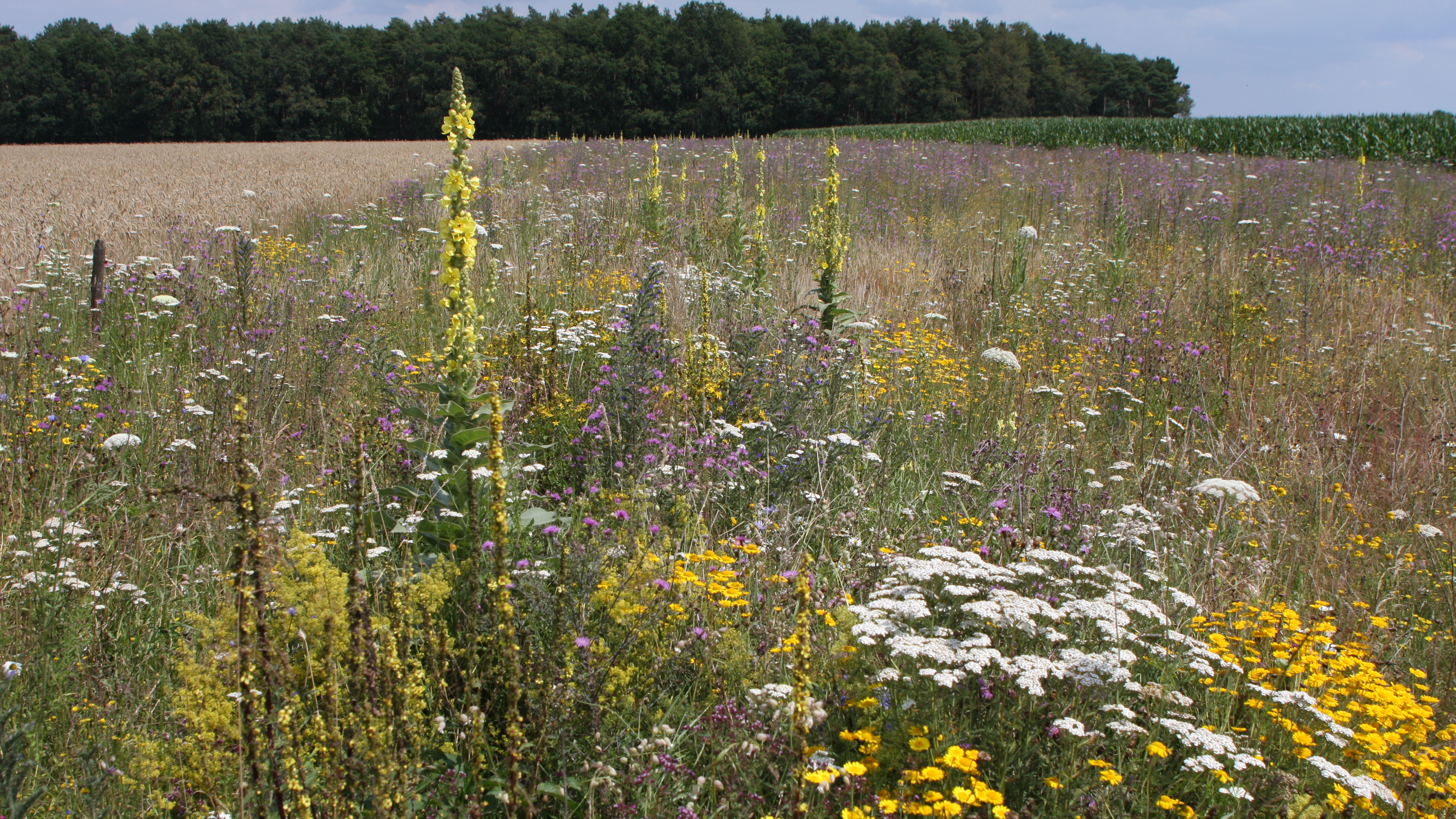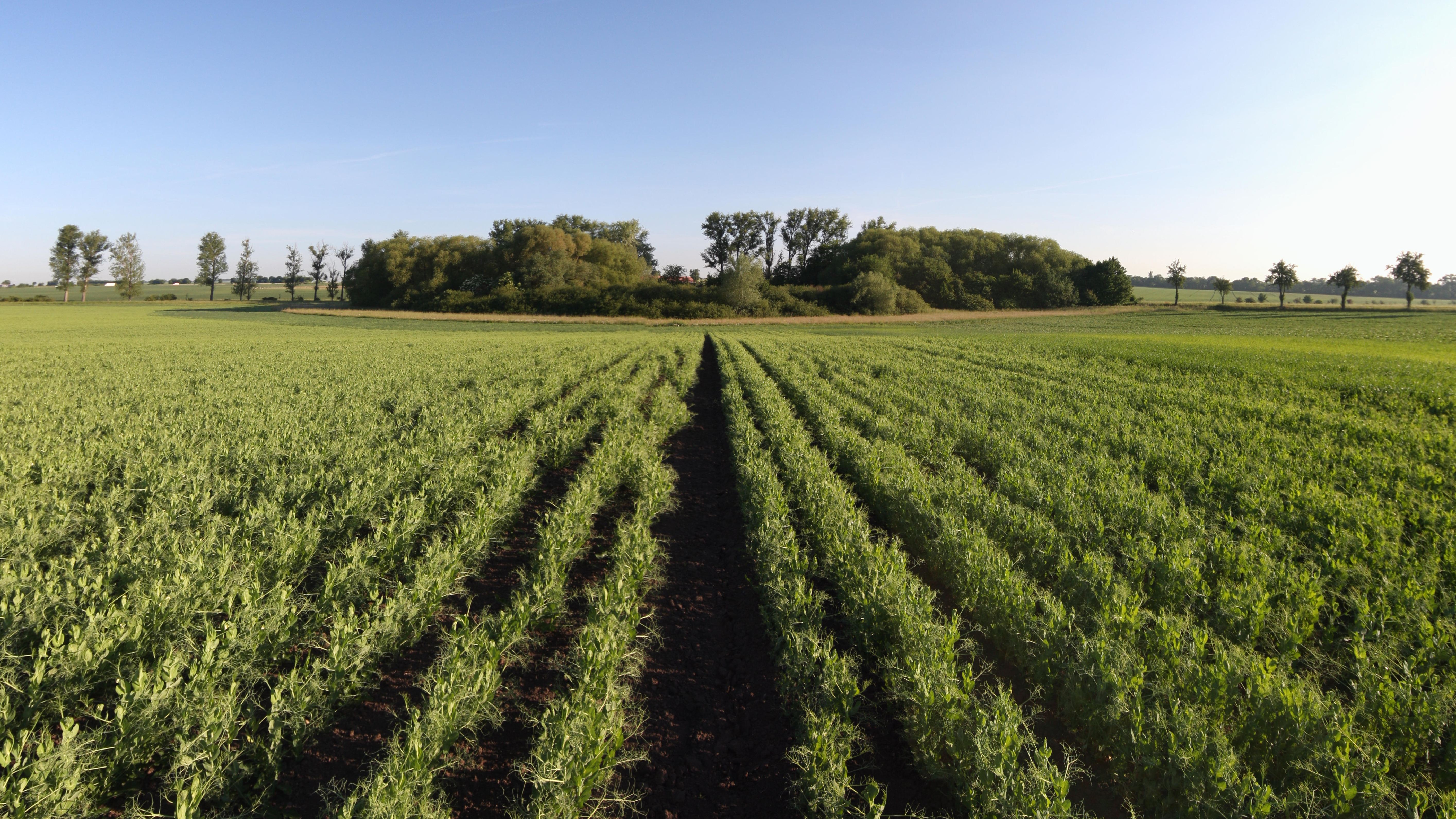Optimizing the establishment of flower strips to benefit the biodiversity in agricultural landscapes with special regard to grassland birds in Saxony-Anhalt
Motivation of the project
Motivation of the project
In promoting biological diversity in the agricultural landscape, Saxony-Anhalt places a major focus on the creation of perennial flower strips / areas with certified, regional wild plant origins within the framework of the agri-environmental and climate measures (AUKM). Especially in structurally poor agricultural landscapes, perennial flower strips fulfill a variety of functions as stepping stones or connecting corridors in the biotope network and serve as feeding, reproduction, retreat and wintering habitats for numerous animal groups, e.g. B. birds, butterflies and wild bees, amphibians, small mammals, ground beetles and spiders, insects and mollusks. They increase the recreational value of the cultural landscape and enrich the landscape. In addition to cultural ecosystem services, they promote important regulatory and provision services such as biological pest control, pollination and soil fertility.
Despite these positive experiences with wild plant flower strips, the AUKM "Perennial flower strips" has been reluctantly accepted by farmers. The poor acceptance is due, among other things, to a not inconsiderable skepticism regarding the success of flower strip mixtures under practical conditions, and there were also fears of weed infestation of the stocks and subsequent sanctions by the control authorities. The existing care requirements for a successful establishment can, however, collide with the protection of meadow breeders (protection of ground-breeding bird species). A possible impairment of meadow breeders is discussed contradictingly among ornithologists. With regard to the effects of flower strips on meadow breeders and optimization There is therefore an urgent need for research into care from the point of view of bird protection, and doubts are being raised about the ecological effectiveness of such measures in the agricultural landscape This is because there are so far only a few scientific studies on the effect of wild plant flower strips on species of higher trophic levels and on the cross-linking effect of these flower strips. Ecologists question the small area of the flower strips.
As part of the project, the perennial flower strips created by farmers in Saxony-Anhalt in the new funding program (RDP 2014-2020) are scientifically evaluated in order to eliminate the knowledge deficits described. In particular, the effects on biological diversity in agricultural landscapes are systematically investigated. Furthermore, acceptance analyzes are carried out among farmers through systematic surveys in order to identify obstacles to implementation and to develop solutions to increase the motivation to participate in the program offered for the creation of perennial wild plant flower strips. Building on the project results, future measures to increase biological diversity in agricultural landscapes are to be optimized.
Project stage 1: Selection of sample site and interviewing of farmers
Project stage 1: Selection of sample site and interviewing of farmers
In the first project phase, the basis for a systematic evaluation of the effects on biological diversity in perennial flower strips in comparison to reference areas is laid. First, an analysis of the landscape ecological situation of the perennial flower strips is carried out. Along the gradient from cleared to structurally rich landscapes, 20 isolated and 20 aggregated flower strips are then selected using a stratified random selection. 20 representative arable land without flower strips are selected as reference areas in order to enable a with / without comparison for the animal species examined and thus to quantify the effect of the perennial flower strips on the occurrence of bird species.
A representative survey on the acceptance of the AUKM "perennial wild plant flower strips" is carried out among farmers in Saxony-Anhalt. In the second phase of the project, the interviews serve as the basis for the development of optimization proposals for future measures to increase biodiversity in agricultural landscapes.
Sample area selection: Anhalt University
Survey of farmers: Stiftung Kulturlandschaft Sachsen-Anhalt
Project stage 2: Data sampling in the field (vascular plants and birds)
Project stage 2: Data sampling in the field (vascular plants and birds)
In the second project phase, the following measurements will be carried out and evaluated on the 40 selected flower strips and on 20 arable areas without flower strips (reference areas):
Floristic mapping of flower strips and reference areas
- Establishment rate and proportion of sown plant species in the total cover (flower strips) and spontaneously emerged plant species and their proportions on the reference strips
- Proportion of nectar and pollen plants and proportion of problematic non-target species
Faunistic surveys of flower strips and reference areas (field birds)
- Recording of field bird species (breeding birds, use as foraging habitat) and potential breeding habitats on flower strips and reference locations (= with / without comparison)
- Recording of the total potential of the examined group of animals in the landscape
- Determination of the proportion and distance of existing habitat types in the vicinity of the study areas
- Comparison of the occurrence of field birds depending on the existing landscape structures and the species potential in the landscape
Project leader
· Hochschule Anhalt: Prof. Dr. Sabine Tischew, Dr. Anita Kirmer
Project partner
· Stiftung Kulturlandschaft Sachsen-Anhalt
Cooperation partner
· Landesanstalt für Landwirtschaft und Gartenbau Sachsen-Anhalt
· Landesamt für Umweltschutz Sachsen-Anhalt
· Bauernverband Sachen-Anhalt. e.V.
Funded by: Ministerium für Umwelt, Landwirtschaft und Energie Sachsen-Anhalt
Project number: A03/2016
Duration: 10/2016 - 12/2017
The following materials are available on the subject of "More biodiversity in the agricultural landscape":
- Measures to promote biodiversity in arable farming (As of June 2018)
- Perennial flower strips
- Poster too "Effects of perennial wild plant flower strips on the floristic and avifaunistic diversity in the agricultural landscape of Saxony-Anhalt" (As of June 2018)





